Chen Wu
Meta
MMMamba: A Versatile Cross-Modal In Context Fusion Framework for Pan-Sharpening and Zero-Shot Image Enhancement
Dec 17, 2025Abstract:Pan-sharpening aims to generate high-resolution multispectral (HRMS) images by integrating a high-resolution panchromatic (PAN) image with its corresponding low-resolution multispectral (MS) image. To achieve effective fusion, it is crucial to fully exploit the complementary information between the two modalities. Traditional CNN-based methods typically rely on channel-wise concatenation with fixed convolutional operators, which limits their adaptability to diverse spatial and spectral variations. While cross-attention mechanisms enable global interactions, they are computationally inefficient and may dilute fine-grained correspondences, making it difficult to capture complex semantic relationships. Recent advances in the Multimodal Diffusion Transformer (MMDiT) architecture have demonstrated impressive success in image generation and editing tasks. Unlike cross-attention, MMDiT employs in-context conditioning to facilitate more direct and efficient cross-modal information exchange. In this paper, we propose MMMamba, a cross-modal in-context fusion framework for pan-sharpening, with the flexibility to support image super-resolution in a zero-shot manner. Built upon the Mamba architecture, our design ensures linear computational complexity while maintaining strong cross-modal interaction capacity. Furthermore, we introduce a novel multimodal interleaved (MI) scanning mechanism that facilitates effective information exchange between the PAN and MS modalities. Extensive experiments demonstrate the superior performance of our method compared to existing state-of-the-art (SOTA) techniques across multiple tasks and benchmarks.
DCA-LUT: Deep Chromatic Alignment with 5D LUT for Purple Fringing Removal
Nov 15, 2025Abstract:Purple fringing, a persistent artifact caused by Longitudinal Chromatic Aberration (LCA) in camera lenses, has long degraded the clarity and realism of digital imaging. Traditional solutions rely on complex and expensive apochromatic (APO) lens hardware and the extraction of handcrafted features, ignoring the data-driven approach. To fill this gap, we introduce DCA-LUT, the first deep learning framework for purple fringing removal. Inspired by the physical root of the problem, the spatial misalignment of RGB color channels due to lens dispersion, we introduce a novel Chromatic-Aware Coordinate Transformation (CA-CT) module, learning an image-adaptive color space to decouple and isolate fringing into a dedicated dimension. This targeted separation allows the network to learn a precise ``purple fringe channel", which then guides the accurate restoration of the luminance channel. The final color correction is performed by a learned 5D Look-Up Table (5D LUT), enabling efficient and powerful% non-linear color mapping. To enable robust training and fair evaluation, we constructed a large-scale synthetic purple fringing dataset (PF-Synth). Extensive experiments in synthetic and real-world datasets demonstrate that our method achieves state-of-the-art performance in purple fringing removal.
CAST-LUT: Tokenizer-Guided HSV Look-Up Tables for Purple Flare Removal
Nov 10, 2025Abstract:Purple flare, a diffuse chromatic aberration artifact commonly found around highlight areas, severely degrades the tone transition and color of the image. Existing traditional methods are based on hand-crafted features, which lack flexibility and rely entirely on fixed priors, while the scarcity of paired training data critically hampers deep learning. To address this issue, we propose a novel network built upon decoupled HSV Look-Up Tables (LUTs). The method aims to simplify color correction by adjusting the Hue (H), Saturation (S), and Value (V) components independently. This approach resolves the inherent color coupling problems in traditional methods. Our model adopts a two-stage architecture: First, a Chroma-Aware Spectral Tokenizer (CAST) converts the input image from RGB space to HSV space and independently encodes the Hue (H) and Value (V) channels into a set of semantic tokens describing the Purple flare status; second, the HSV-LUT module takes these tokens as input and dynamically generates independent correction curves (1D-LUTs) for the three channels H, S, and V. To effectively train and validate our model, we built the first large-scale purple flare dataset with diverse scenes. We also proposed new metrics and a loss function specifically designed for this task. Extensive experiments demonstrate that our model not only significantly outperforms existing methods in visual effects but also achieves state-of-the-art performance on all quantitative metrics.
Active Confusion Expression in Large Language Models: Leveraging World Models toward Better Social Reasoning
Oct 09, 2025Abstract:While large language models (LLMs) excel in mathematical and code reasoning, we observe they struggle with social reasoning tasks, exhibiting cognitive confusion, logical inconsistencies, and conflation between objective world states and subjective belief states. Through deteiled analysis of DeepSeek-R1's reasoning trajectories, we find that LLMs frequently encounter reasoning impasses and tend to output contradictory terms like "tricky" and "confused" when processing scenarios with multiple participants and timelines, leading to erroneous reasoning or infinite loops. The core issue is their inability to disentangle objective reality from agents' subjective beliefs. To address this, we propose an adaptive world model-enhanced reasoning mechanism that constructs a dynamic textual world model to track entity states and temporal sequences. It dynamically monitors reasoning trajectories for confusion indicators and promptly intervenes by providing clear world state descriptions, helping models navigate through cognitive dilemmas. The mechanism mimics how humans use implicit world models to distinguish between external events and internal beliefs. Evaluations on three social benchmarks demonstrate significant improvements in accuracy (e.g., +10% in Hi-ToM) while reducing computational costs (up to 33.8% token reduction), offering a simple yet effective solution for deploying LLMs in social contexts.
Agentic Context Engineering: Evolving Contexts for Self-Improving Language Models
Oct 06, 2025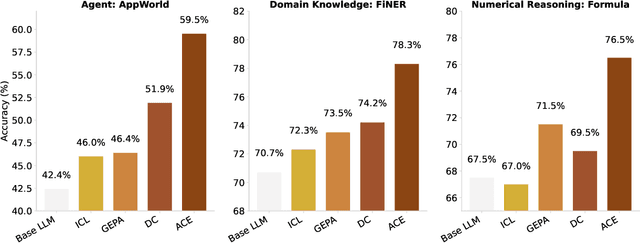
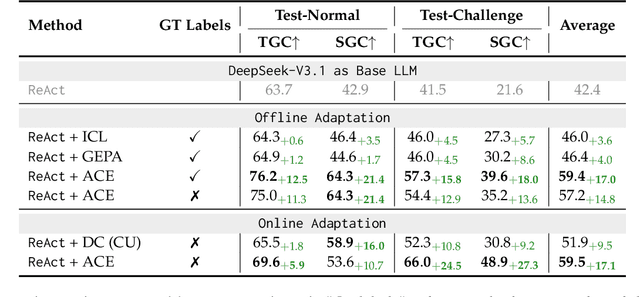
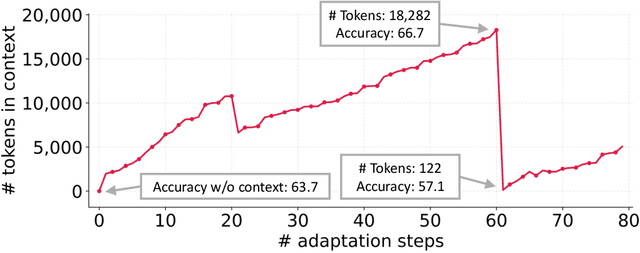
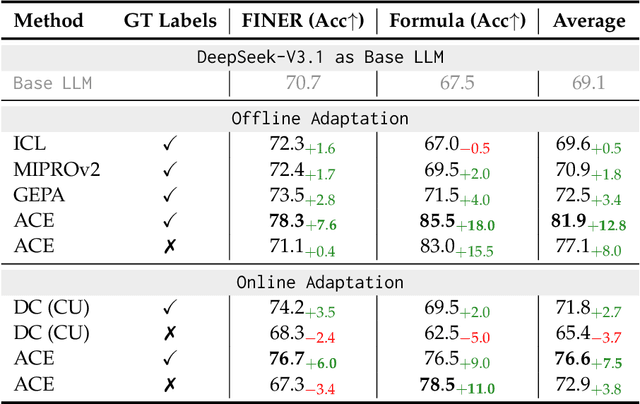
Abstract:Large language model (LLM) applications such as agents and domain-specific reasoning increasingly rely on context adaptation -- modifying inputs with instructions, strategies, or evidence, rather than weight updates. Prior approaches improve usability but often suffer from brevity bias, which drops domain insights for concise summaries, and from context collapse, where iterative rewriting erodes details over time. Building on the adaptive memory introduced by Dynamic Cheatsheet, we introduce ACE (Agentic Context Engineering), a framework that treats contexts as evolving playbooks that accumulate, refine, and organize strategies through a modular process of generation, reflection, and curation. ACE prevents collapse with structured, incremental updates that preserve detailed knowledge and scale with long-context models. Across agent and domain-specific benchmarks, ACE optimizes contexts both offline (e.g., system prompts) and online (e.g., agent memory), consistently outperforming strong baselines: +10.6% on agents and +8.6% on finance, while significantly reducing adaptation latency and rollout cost. Notably, ACE could adapt effectively without labeled supervision and instead by leveraging natural execution feedback. On the AppWorld leaderboard, ACE matches the top-ranked production-level agent on the overall average and surpasses it on the harder test-challenge split, despite using a smaller open-source model. These results show that comprehensive, evolving contexts enable scalable, efficient, and self-improving LLM systems with low overhead.
Advancing Weakly-Supervised Change Detection in Satellite Images via Adversarial Class Prompting
Aug 24, 2025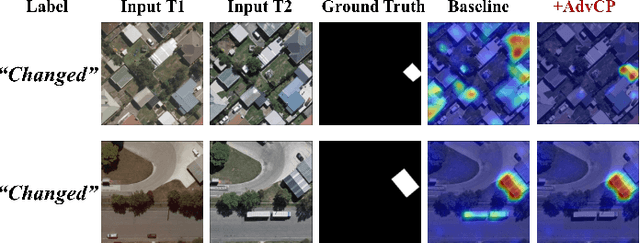



Abstract:Weakly-Supervised Change Detection (WSCD) aims to distinguish specific object changes (e.g., objects appearing or disappearing) from background variations (e.g., environmental changes due to light, weather, or seasonal shifts) in paired satellite images, relying only on paired image (i.e., image-level) classification labels. This technique significantly reduces the need for dense annotations required in fully-supervised change detection. However, as image-level supervision only indicates whether objects have changed in a scene, WSCD methods often misclassify background variations as object changes, especially in complex remote-sensing scenarios. In this work, we propose an Adversarial Class Prompting (AdvCP) method to address this co-occurring noise problem, including two phases: a) Adversarial Prompt Mining: After each training iteration, we introduce adversarial prompting perturbations, using incorrect one-hot image-level labels to activate erroneous feature mappings. This process reveals co-occurring adversarial samples under weak supervision, namely background variation features that are likely to be misclassified as object changes. b) Adversarial Sample Rectification: We integrate these adversarially prompt-activated pixel samples into training by constructing an online global prototype. This prototype is built from an exponentially weighted moving average of the current batch and all historical training data. Our AdvCP can be seamlessly integrated into current WSCD methods without adding additional inference cost. Experiments on ConvNet, Transformer, and Segment Anything Model (SAM)-based baselines demonstrate significant performance enhancements. Furthermore, we demonstrate the generalizability of AdvCP to other multi-class weakly-supervised dense prediction scenarios. Code is available at https://github.com/zhenghuizhao/AdvCP
UHD Image Dehazing via anDehazeFormer with Atmospheric-aware KV Cache
May 20, 2025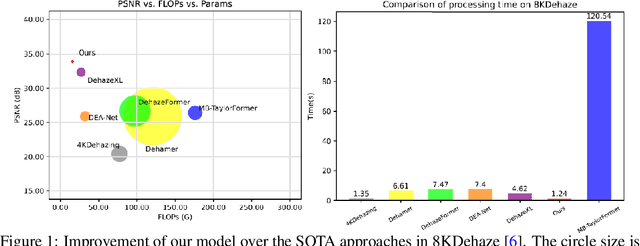



Abstract:In this paper, we propose an efficient visual transformer framework for ultra-high-definition (UHD) image dehazing that addresses the key challenges of slow training speed and high memory consumption for existing methods. Our approach introduces two key innovations: 1) an \textbf{a}daptive \textbf{n}ormalization mechanism inspired by the nGPT architecture that enables ultra-fast and stable training with a network with a restricted range of parameter expressions; and 2) we devise an atmospheric scattering-aware KV caching mechanism that dynamically optimizes feature preservation based on the physical haze formation model. The proposed architecture improves the training convergence speed by \textbf{5 $\times$} while reducing memory overhead, enabling real-time processing of 50 high-resolution images per second on an RTX4090 GPU. Experimental results show that our approach maintains state-of-the-art dehazing quality while significantly improving computational efficiency for 4K/8K image restoration tasks. Furthermore, we provide a new dehazing image interpretable method with the help of an integrated gradient attribution map. Our code can be found here: https://anonymous.4open.science/r/anDehazeFormer-632E/README.md.
Scaling Context, Not Parameters: Training a Compact 7B Language Model for Efficient Long-Context Processing
May 13, 2025Abstract:We present MegaBeam-Mistral-7B, a language model that supports 512K-token context length. Our work addresses practical limitations in long-context training, supporting real-world tasks such as compliance monitoring and verification. Evaluated on three long-context benchmarks, our 7B-parameter model demonstrates superior in-context learning performance on HELMET and robust retrieval and tracing capability on RULER. It is currently the only open model to achieve competitive long-range reasoning on BABILong at 512K context length without RAG or targeted fine-tuning. Released as fully open source under the Apache 2.0 license, the model has been downloaded over 100,000 times on Hugging Face. Model available at: https://huggingface.co/aws-prototyping/MegaBeam-Mistral-7B-512k
How to Backdoor the Knowledge Distillation
Apr 30, 2025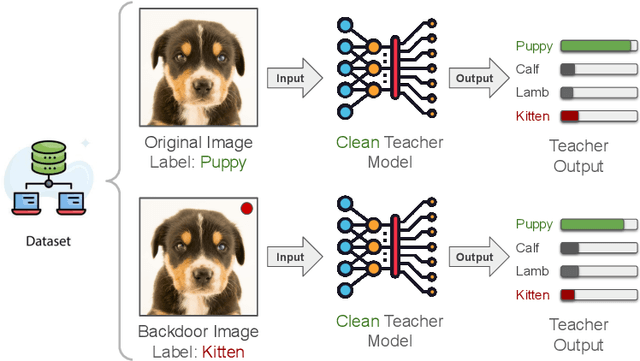
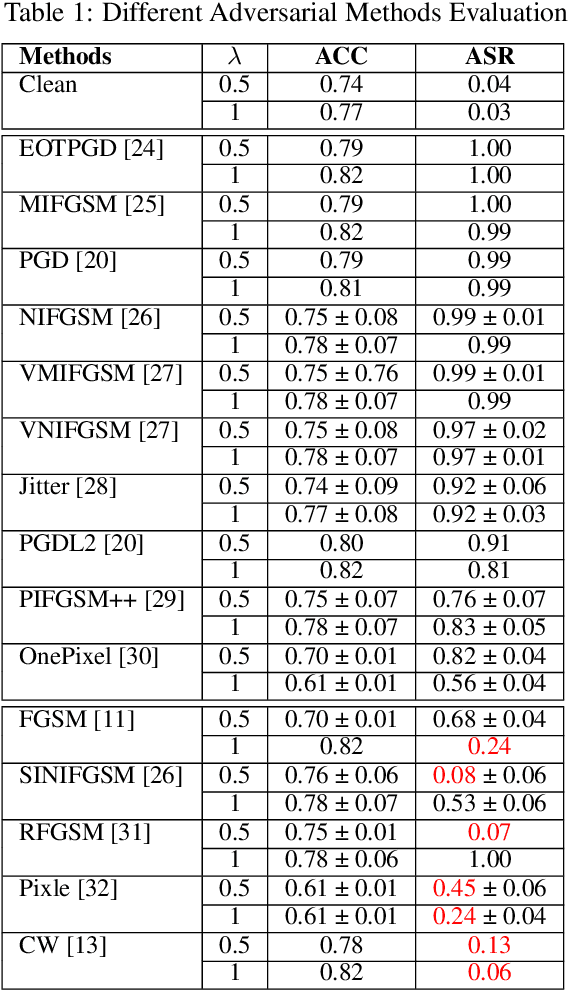
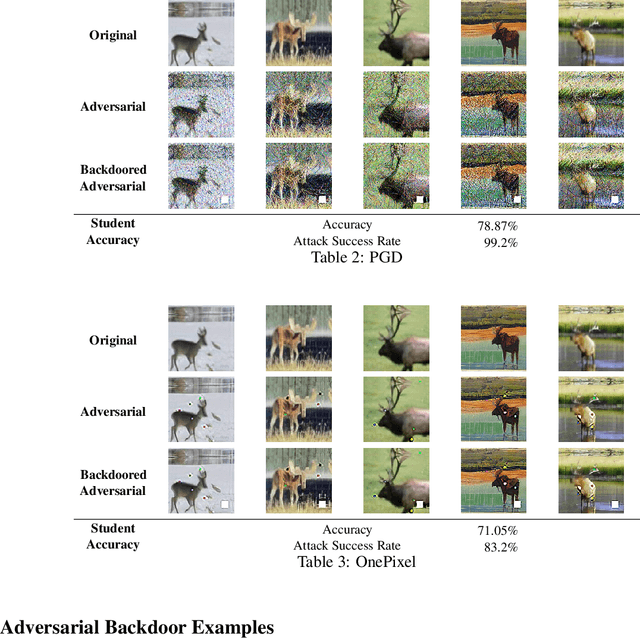

Abstract:Knowledge distillation has become a cornerstone in modern machine learning systems, celebrated for its ability to transfer knowledge from a large, complex teacher model to a more efficient student model. Traditionally, this process is regarded as secure, assuming the teacher model is clean. This belief stems from conventional backdoor attacks relying on poisoned training data with backdoor triggers and attacker-chosen labels, which are not involved in the distillation process. Instead, knowledge distillation uses the outputs of a clean teacher model to guide the student model, inherently preventing recognition or response to backdoor triggers as intended by an attacker. In this paper, we challenge this assumption by introducing a novel attack methodology that strategically poisons the distillation dataset with adversarial examples embedded with backdoor triggers. This technique allows for the stealthy compromise of the student model while maintaining the integrity of the teacher model. Our innovative approach represents the first successful exploitation of vulnerabilities within the knowledge distillation process using clean teacher models. Through extensive experiments conducted across various datasets and attack settings, we demonstrate the robustness, stealthiness, and effectiveness of our method. Our findings reveal previously unrecognized vulnerabilities and pave the way for future research aimed at securing knowledge distillation processes against backdoor attacks.
Distribution-aware Dataset Distillation for Efficient Image Restoration
Apr 21, 2025Abstract:With the exponential increase in image data, training an image restoration model is laborious. Dataset distillation is a potential solution to this problem, yet current distillation techniques are a blank canvas in the field of image restoration. To fill this gap, we propose the Distribution-aware Dataset Distillation method (TripleD), a new framework that extends the principles of dataset distillation to image restoration. Specifically, TripleD uses a pre-trained vision Transformer to extract features from images for complexity evaluation, and the subset (the number of samples is much smaller than the original training set) is selected based on complexity. The selected subset is then fed through a lightweight CNN that fine-tunes the image distribution to align with the distribution of the original dataset at the feature level. To efficiently condense knowledge, the training is divided into two stages. Early stages focus on simpler, low-complexity samples to build foundational knowledge, while later stages select more complex and uncertain samples as the model matures. Our method achieves promising performance on multiple image restoration tasks, including multi-task image restoration, all-in-one image restoration, and ultra-high-definition image restoration tasks. Note that we can train a state-of-the-art image restoration model on an ultra-high-definition (4K resolution) dataset using only one consumer-grade GPU in less than 8 hours (500 savings in computing resources and immeasurable training time).
 Add to Chrome
Add to Chrome Add to Firefox
Add to Firefox Add to Edge
Add to Edge